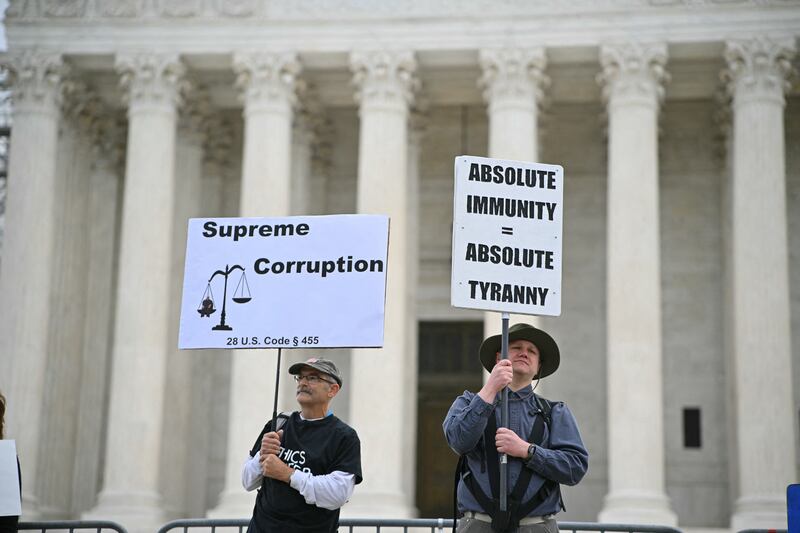The U.S. Supreme Court has continued its expansion of President Trump’s powers and the use of its emergency docket in its recent ruling allowing him to fire members of the National Labor Relations Board (NLRB) and Merit Systems Protection Board (MSPB)—an action that up until now was prohibited by precedent dating back 90 years.
The Humphrey’s Executor case is a foundational building block for the principle that the President isn’t a ruler but rather heads one branch of a government—and in a system where any head of the executive branch is restricted from simply remaking the other branches to fit their own agenda, or chopping them off entirely.
William Humphrey was a Federal Trade Commission member appointed by President Coolidge and then reappointed by President Hoover pursuant to the Federal Trade Commission Act which allowed his removal from that position only for “inefficiency, neglect of duty, or malfeasance.” Despite this, F.D.R., three months into office and desiring commissioners more sympathetic to his New Deal, asked Humphrey to resign. Humphrey refused to do so and F.D.R. fired him.
Five months later, Humphrey died, but his executor litigated the case all the way to the Supreme Court seeking Humphrey’s backpay. The high court ruled unanimously in favor of Humphrey, finding that F.D.R. had exceeded his Constitutional authority.
Like the 1935 Supreme Court, two different federal trial courts found it quite plain that President Trump lacked the power to remove Gwynne Wilcox from the NLRB and Cathy Harris from the MSPB. Both ordered Trump to keep the officials in their respective jobs. But in a 6-3 decision, the current Supreme Court sided with the Trump administration. Troublingly, the Court did so despite recognizing “the relevant statutes prohibit the president from removing these officers without cause” and that “no qualifying cause was given.”

Even more troubling is the fact that the case was resolved through the emergency docket process, by which full arguments and briefings are skipped and “orders” rather than opinions are issued under the idea that the expedited process is necessitated by emergency.
This decision continues the alarming trend from the conservative majority—respecting precedent only when it suits their ideology. Enhancing the power of the President under a unitary executive theory has been a long-game effort by legal conservatives, but the combination of that transactional judicial analysis with overuse of the emergency docket may not only put stare decisis on a path towards its deathbed but also the effectiveness the high court.
The unprecedented increase in the use of the emergency docket similarly undermines the lower courts and the processes in place to check excesses by the executive branch. It also makes one question who is really making the call as to what cases merit emergency attention. As The Hill put it: “Forget 911. When the Trump administration has an emergency, it just calls nine—justices, that is.” This willingness to take on all cases immediately may reflect a conceit that the justices (at least the conservative ones) increasingly don’t hide: That the high court’s ability to act fast negates the need for lower courts to issue nation-wide injunctions. This approach, if fully implemented, would make the Supreme Court not the court of last resort but the only court.
In theory, the court’s taking on these cases could be seen as perhaps a willingness to take on the task of reining in Trump’s excesses. But thus far they seem avoidant of direct confrontation. The instructions to the Department of Justice in the illegal deportation of Kilmar Abrego Garcia to a brutal Venezuelan prison were not a forceful “bring him back” but rather a wishy-washy directive to “facilitate” his return.
Fear of an outright refusal by Trump to obey rulings might motivate the court’s hesitancy; they may calculate that piecemeal capitulations will postpone confrontation thus protecting their authority. But robust rulings set by lower courts cases allow the high court to use judicial restraint in its decisions. Without it, restraint becomes avoidant behavior that undermines the court’s effectiveness while emboldening the Trump administration’s overreach.
Perhaps blinded by their own egos and sense of self-importance, the Roberts-led conservative majority seems to relish the conceit that only they have the legal chops to manage legal cases in the Trump era. But such hubris actually undercuts the judiciary’s effectiveness and, up against a figure like Trump who will seek to convert every inch given him into a mile, it may be undercut to the point of irrelevance.








